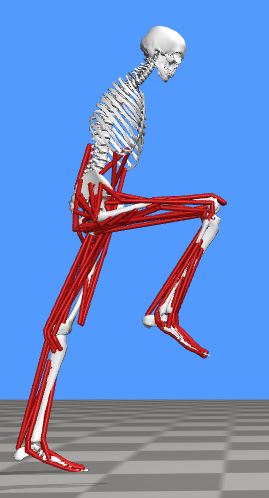Knee to Chest Mobility
Knee to chest mobility is the most important mobility characteristic of a cyclist. Most cyclists struggle to maintain mobility in this domain and slowly become weaker and less flexible. Let's look at what knee to chest mobility is and why it's important.
What is knee to chest mobility?
Knee to chest mobility is the ability to bring your knee upward toward your chest. It most closely simulates the top of the pedal stroke for a cyclist. In this position, the knee is bent and the hip is flexed as much as possible.

To get an idea of your knee to chest mobility, lay on your back and place your sacrum (the bone in the center at the bottom of your spine) flat on the floor. Anchoring the sacrum on the floor allows for standardization as changes in pelvic angle can affect the results of the test. Next, just bring your knee to your chest without assistance. The angle your upper leg makes with your torso is a quantification of your knee to chest mobility.
And how does it relate to cycling?
Your knee to chest mobility limits your bike fit significantly by limiting your seat height options. Specifically, the lower your seat height, the more knee to chest mobility is required. So riders with poor knee to chest mobility will have high seat heights, putting extra strain on their hamstrings. Another way to artificially increase knee to chest mobility is to go into a posterior pelvic tilt. A rider will tuck their pelvis backwards and their butt gets 'sucked under' the saddle. This method gives the hips more space, but limits glute activation and pulls on the spine.


The reason knee to chest mobility matters is because when we fail to have the mobility to sufficiently raise our knee towards our chest, we start to engage in improper motor patterns; motor patterns that cause injury in the long term. The major signs of a lack of knee to chest mobility are:
- Excessive posterior tilt
- A bike fit with an unusually high saddle height
- Knees that splay outward at the top of the pedal stroke
- A pelvis that rocks back and forth during pedalling
Biomechanical fixes
A bike fitter may adapt your fit to accommodate your lack of mobility, but this is not a long term solution. Long term solutions involve making changes to your own body to improve your mobility. The biggest single change you can make is to stretch your glutes. The glutes are the main hip extensors in the human body and the knee to chest position is hip flexion with a bent knee, thus the glutes are extended. If they are tight and cannot extend enough, your range of motion becomes limited. Stretching is the best way to improve this range of motion.
Conclusion
Knee to chest mobility is essential to cycling, our knees come up to our chest thousands of times every day we bike. It may be a good idea to regularly test your knee to chest mobility throughout the training year. If your mobility starts to decrease, you may be at risk for overuse injuries. It's important to be careful, stretch, and learn about your body to best counteract any changes in your mobility.